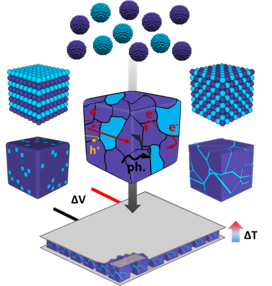High-Performance Thermoelectric Nanocomposites from Nanocrystal Building Blocks
The efficient conversion of thermal energy to electricity and vice versa by means of solid-state thermoelectric devices has been a long-standing goal. However, its cost-effectiveness is hampered by the relatively low efficiency and high production cost of current thermoelectric materials. Therefore, materials with significantly improved performance need to be developed to enable a successful deployment of thermoelectric systems in their wide application range. The efficiency of TE devices depends on three interrelated material parameters: the electrical conductivity, s, the Seebeck coefficient, S, and the thermal conductivity, k. These parameters are grouped into a dimensionless figure of merit, ZT, defined as ZT=sS2Tk-1 where T is the absolute temperature.
Nanostructuration has been proven helpful to reach the very particular group of properties required to achieve high thermoelectric performances: high s, high S, and low k (Chem. Soc. Rev. 2017, DOI: 10.1039/C6CS00567E). Nanodomains within a crystalline matrix can inject large charge carrier concentrations without significant influence on their mobility, thus reaching high electrical conductivities. Moreover, nanostructured materials contain high density of interfaces that efficiently scatter mid- and long-wavelength phonons hence reducing the thermal conductivity. Finally, nanocrystalline domains can increase the Seebeck coefficient by modifying the density of states and/or providing type- and energy-dependent charge carrier scattering. All these advantages can only be reached when engineering a complex type of material, nanocomposites, with exquisite control over structural and chemical parameters at multiple length scales. Current conventional nanomaterial production technologies lack such level of control, thus alternative strategies need to be developed and adjusted to the specifics of the field. A particularly suitable approach to produce nanocomposites with unique level of control over their structural and compositional parameters is their bottom-up engineering from solution-processed nanoparticles. Herein, we present the synthesis of nanoparticles of suitable materials with precisely engineered composition and surface chemistry, their combination and consolidation into nanostructured materials, and the strategies to electronically dope such materials to overall produce high performance thermoelectric materials.
